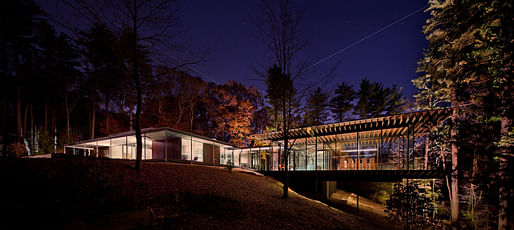
For this month's Wide Lens, a column that investigates the relationship between architect and photographer, Photography & Architecture editor Julie Grahame shares some insight from her interview with architectural photographer, Scott Frances.
Julie Grahame:
Post Production and Retouching of Architectural Imagery
Master architectural photographer Scott Frances has been in the industry for more than 25 years. He assisted Ezra Stoller in the 1980s, and was introduced by him to Richard Meier in 1988. Meier recalls the meeting in his preface to Frances' book, "MonoVisioN," saying "From my first encounter with Scott I was able to sense a particularly sensitive response to experiencing architecture in his work, and we started a good relationship that extends from the Grotta Residence all the way to my most recent residential project in Brooklyn, New York."
Frances is also a partner in New York's high-end House Tribeca photo retouching house. Who better, then, to give us some thoughts on post-production in his field?

Scott Frances:
"The perception, the meme, that post production and retouching of architectural imagery makes photographs look like renderings is the result of two very different causes. The first is that bad processing and retouching certainly can make photographs appear flat and one-dimensional as renderings typically look. The second reason is our "perception" is colored by our expectations of what a photograph "really" should look like, that analog (film) photographs render the world they capture more realistically than does digital imagery. I think this belief is rooted in our want to cling to our past, for romantic or simply behavioral conditioning reasons (we are used to it).
"An objective look at the way the human eye sees the world as compared to the way film or digital photographs render it, shows that in every measurable way properly processed digital images are much closer to our living experience than properly processed film images. Our eye sees both the shadow and the highlights in the world around us, for example when we stand in a dim room we are also able to see the view out the window. Can film recreate this experience? Absolutely not, but digital can because it has far greater exposure latitude than any film ever had. Does film really render color better than digital, can it differentiate subtleties of color as it moves from shadow areas or brighter area? How could it, inasmuch as it struggles with contrast, as illustrated by the room/view example. Contrast is not limited to the world of black and white. Paradoxically, the one area in which film actually is "better" than digital is that it renders a much sharper image. It requires a medium format sensor to match the sharpness of a 35mm piece of film. But do most of us actually see the world this sharply? I would argue not, given the scope of the eyeglass and contact lens industry.

"The commissioning clients needs to learn to differentiate between poor and great digital processing. Unfortunately, driven by economic reasons, most digital imagery is very poorly processed. Similarly, most film was very poorly processed at the local drug store. If you wanted your film to look really good, you wouldn't drop it off at Walmart, you'd send it to a professional lab and expert printer, and if you wanted exceptional results you would work in concert with them. Similarly, if you want your digital images to look as good as they possible can then you need a great retoucher working in concert with you and your photographer. Rarely is a good photographer a great retoucher; these fields of expertise are very far apart - one works and sees in the three-dimensional world, the other strictly in a two-dimensional one.
"Digital photography is closer to the way we see the world, just as 19th century photography was as compared to 18th century painting. We just need to get used to it."
No Comments
Block this user
Are you sure you want to block this user and hide all related comments throughout the site?
Archinect
This is your first comment on Archinect. Your comment will be visible once approved.